 Early Cretaceous
Early CretaceousLiaoning China
from the Dinosaur Collector
More Diorama Pages Asian Diorama Pages
update 012907
Liaoning now considered by most experts to date from the Early
Cretaceous. At that time the region was occupied by a shallow, warm lake with abundant fish and bird life.
The lake itself lay in a fault basin flanked by volcanoes, and it is this particular feature that makes the area
so important. Sporadic volcanic eruptions killed large numbers of animals and buried the remains rapidly
before significant decomposition could take place. These specialized conditions have resulted in better
preservation of soft tissue than is found virtually anywhere else, including the famous Solnhofen deposits
in Germany that preserved the Archaeopteryx feather. Dragonfly wings, feathers and fur are all preserved,
and coupled with an enormous number and type of fossilized animals, it is not surprising that the site is
viewed as one of the most exciting and promising yet discovered.
A rich fauna of insects, molluscs, crustaceans, fish (more than 10,000 specimens of 1 species of freshwater
fish, Lycoptera), mammals and birds (including hundreds of skeletons of Confuciusornis) have been
recovered, but, at least in recent years, these have to some extent been surpassed by the dinosaurs.
Following the discovery of the controversial and still hotly debated “feathered dinosaur” Sinosauropteryx
in 1992, the region has yielded Protarchaeopteryx, Caudipteryx (both now considered dinosaurs rather
than primitive birds as originally suggested), the therizinosaurid Beipiaosaurus and the dromaeosaurid
Sinornithosaurus. All of these dinosaurs exhibit the remains of integumentary fibres that are either
definitely feathers (Protarchaeopteryx and Caudipteryx) or more arguably some sort of proto-feather. Feathers clearly did not evolve
primarily for flight, and may have developed for insulation, display, or even as a metabolic clearance
system for excess sulphur), it is generally considered that the discovery of a genuine feathered dinosaur
would be the definitive proof of the dinosaurian origin of birds.
Thus the announcement by Chinese paleontologists that they had discovered just such a beast was met with
claim and counter-claim. Sinosauropteryx, a basal coelurosaur related to Compsognathus, shows evidence
of some type of integumentary structure, but after lengthy and often heated debate, it is still not clear
exactly what these structures might be. They are clearly not modern feathers, and almost as clearly not a
collagen frill as some have proposed. Whether they are some sort of proto-feather remains to be seen.
While the jury may still be out on the integument of Sinosauropteryx, for three more Chinese finds from
the same area there is no doubt at all that they are feathered. Protarchaeopteryx and Caudipteryx were first
announced as basal birds, largely on the basis of their feathers. However, several investigators have since
demonstrated by cladistic analysis that both are theropods - Caudipteryx is an oviraptorosaur and
Protarchaeopteryx a maniraptoran. Finally, a feathered therizinosaurid, Beipiaosaurus, was
discovered, as well as the dromaeosaurid Sinornithosaurus and several other similar specimens. Despite
counter-claims that these are simply flightless birds, most seem to accept that feathers arose within the
theropod lineage somewhere, the remaining question being just how far back were they represent.
Microraptor zhaoianus (Small robber) is the name given to fossils which includes the dromaeosaurid rear half of the infamous chimera Archaeoraptor. It is the first dinosaur that is smaller than Archaeopteryx. Fuzz-like remains from the pelvic area are similar to that of Beipiaosaurus and Sinornithosaurus but with a central rachis. Microraptor gui the second species show complete covering of 2 types of feathers proto-feathers and flight feathers. It may have been a 4-winged glider. The legs of the two-pound creature could have been held below the body in flight, creating two staggered wing sections, the upper one slightly ahead of the lower one. One other flying dinosaur, Pedopenna, also had feathers on its legs and modern raptors such as falcons have short feathers on their upper legs which reduce air resistance as they fly.
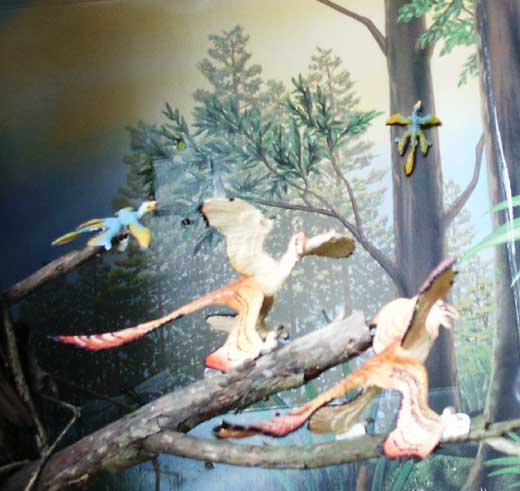
Carnegie Safari and Safari Ltd ANHM Feathered Dino toob Mircroraptor gui.
Mircroraptor gui was proably a glider and could represent an intermediate stage before flight or an alternative to the winged flight used by birds that didn't make it. With its flight feathers on both the arms and legs it could spread them to create a gliding surface to fly from tree to tree. The feathered tail may have been a steering organ. It could be a relative of birds, raptors or troodontids.
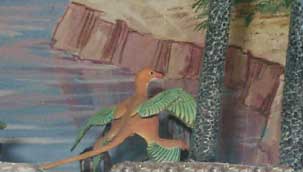
Kaiyodo Wonderous World of Dinosaurs Mircroraptor gui.
. Sinornithosaurus(Chinese bird lizard) is a small dromaeosaurid of about 4 feet. As with other Chinese dinosaurs from the same region, its body was apparently covered with a layer of proto-feathers like the bird Confuciusornis.
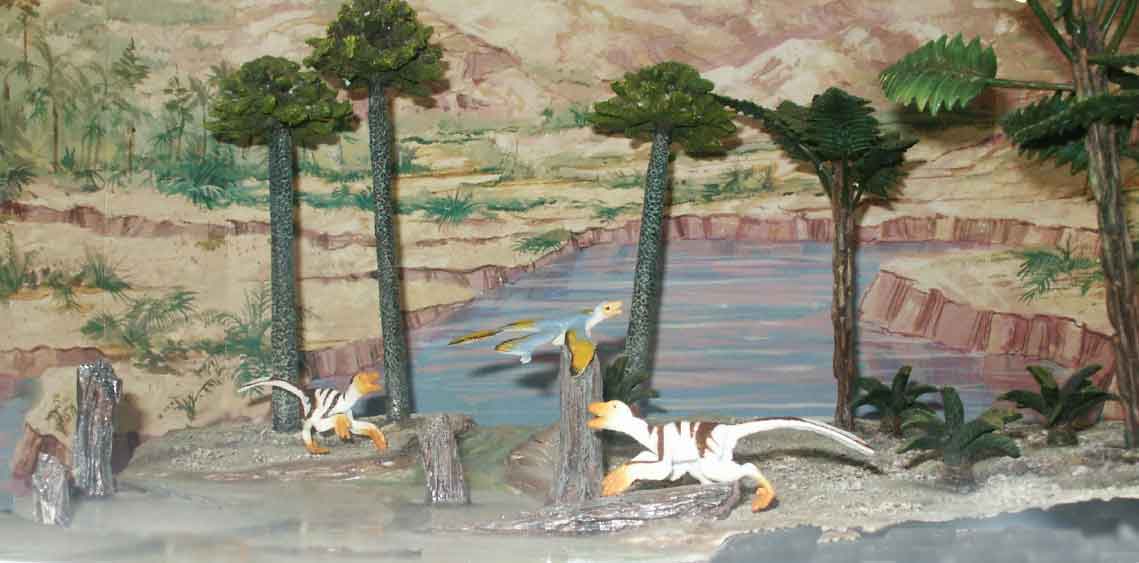
Safari Ltd ANHM Feathered Dino tube Sinornithosaurus and Mircroraptor gui. Kinto diorama courtesy of Toyosaurus.
At the end of the Jurassic through the Early Cretaceous the splitting of the northern continents created rifts valleys. These contained long lived lake environments had clear water with fine sediments from the volcanoes that allowed details of the feathers to be preserved. The lakes supported a flora of conifers, gingkoes, ferns and horsetails. Besides a bevy of hairy feathered small theropods there is the horse sized Jinzhousaurus (Jinzhou lizard) a large iguanodontid with a mixture of primitive and advanced characters, and in some characters resembles early hadrosaurs. The earliest bona fide tyrannosaur is Dilong paradoxus. It was discovered in rocks about 128 million years old. Dilong had features common to many more primitive theropods—the group of dinosaurs most closely related to birds—such as a hand with three fingers (most tyrannosaurs’ hands had just two fingers) and a relatively small body (it was just five feet long). But Dilong also had skeletal features, skull openings, and teeth that were characteristic of tyrannosaurs. In particular, the teeth at the front of its snout had D-shaped cross-sections.
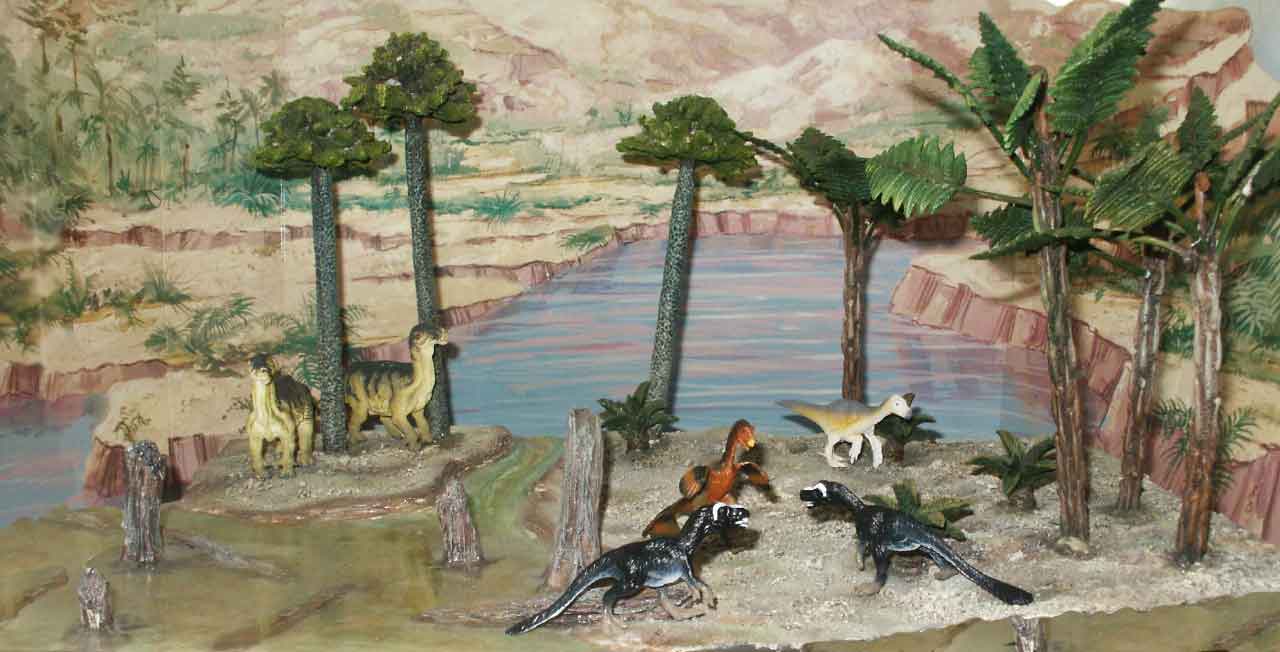
Safari Ltd ANHM Feathered Dino tube Beipiaosaurus, Dilong and Caudipteryx. The AAA Edmontosaurus stands in for Jinzhousaurus. Kinto diorama courtesy of Toyosaurus.
Beipiaosaurus (Lizard from Beipiao) is yet another of the exciting new finds from the Liaoning area of China.
The discoverers believe that integumentary filaments up to 70 mm (2.75 in) in length similar to those of
Sinosauropteryx represent proto-feathers and suggest that such structures may have been broadly
distributed among non-avian theropods. Beipiaosaurus differs from other therizinosaurs in having a larger
skull, and morphological differences in the teeth, hand, pelvis and feet.
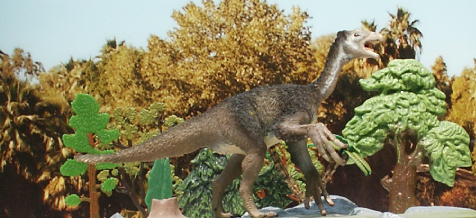
Carnegie Safari Beipiaosaurus
Caudipteryx (Tail feather) is characterized by paired feathers on either side of the end of the tail, long feathers on its arms and evidence that its entire body may have been covered with feathers of some sort, including down-like covering. All feathers are symmetrical, and together with the arms (shorter than most other non-avian coelurosaurs) and the long legs indicate that it probably could not fly and was a ground dwelling runner.
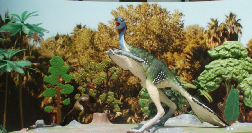
Carnegie Safari Caudipteryx. The Feathered Dinosaurs series are the finest piece of work by Forest Rogers the sculptor for the Carnegie Safari series. They have set a new standard for toy lines These vinyl toy figures are equal to or superior to the resin display figures from Japan.. Ironically Forest had proposed a feathered Caudipteryx years earlier but the Safari management at the time felt the public wasn't ready. New management a Safari coupled with the well published finds in Liaoning gave the go ahead to stun collectors and excite kids.
Dilong (Emperor Dragon) is a small, basal tyrannosauroid with relatively long arms and three-fingered hands. Although its skull shows many characteristics of tyrannosaurids, its postcranial skeleton is more like a coelurosaurian. It is the earliest known definite tyrannosauroid, and the integumentary structures found associated with some tail bones resemble those of Sinornithosaurus and other Liaoning coelurosaurs and represent the first evidence of such “feather-like” features in tyrannosaurs.
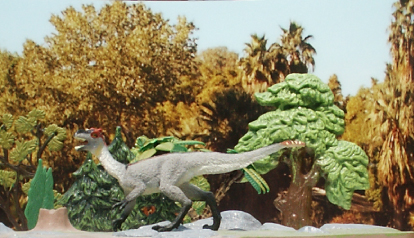
Carnegie Safari Dilong.
Click on the Site A icon Dioramas organized by period or by manufacturer.